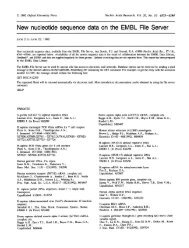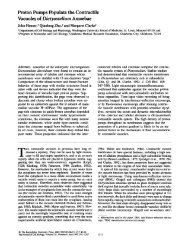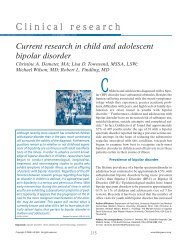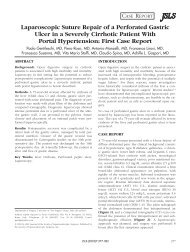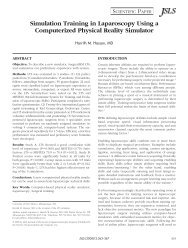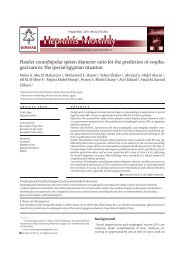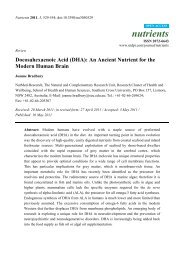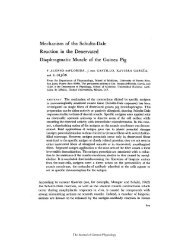Prevalence of oral lesions among Saudi dental ... - BioMedSearch
Prevalence of oral lesions among Saudi dental ... - BioMedSearch
Prevalence of oral lesions among Saudi dental ... - BioMedSearch
Create successful ePaper yourself
Turn your PDF publications into a flip-book with our unique Google optimized e-Paper software.
Percentage (%)<br />
366<br />
25<br />
20<br />
15<br />
10<br />
5<br />
0<br />
original article<br />
<strong>Saudi</strong> Arabia, for an <strong>oral</strong> examination and a <strong>dental</strong><br />
treatment plan. The study sample included adult subjects<br />
who were older than 15 years <strong>of</strong> age. The college<br />
is an open public facility and referral hospital. A total<br />
<strong>of</strong> 2552 patients were interviewed and clinically investigated<br />
for the presence <strong>of</strong> <strong>oral</strong> <strong>lesions</strong> from June 2002-<br />
to December 2005. History taking and a thorough <strong>oral</strong><br />
clinical examination was performed, including a radiographic<br />
examination. The type and distribution <strong>of</strong> the<br />
<strong>oral</strong> mucosal conditions was recorded. An interview<br />
was conducted to collect information. The examination<br />
was performed by a single examiner. Data were statistically<br />
analyzed using SPSS (SPSS, Inc. Chicago, IL).<br />
RESULTS<br />
Among the 2552 patients, only 383 patients (15.0%)<br />
had <strong>oral</strong> <strong>lesions</strong>. Females constituted 57.7% (n=221)<br />
and males 42.3% (n=162). The age range <strong>of</strong> the patients<br />
was between 15 to 73 years. The mean age <strong>of</strong> the sample<br />
group was 38.2 years. The mean age for females was<br />
33.0 years and 47.1 years for males. Of the total sample,<br />
the most commonly affected age was between 31 to<br />
40 years (21.4%), followed by 15 to 20 years (18.5%),<br />
and 21 to 30 years (17.8%) (Figure 1). Twenty-four patients<br />
(0.9%) admitted smoking habits and 196 patients<br />
(7.7%) had a systemic disease, but there were no differences<br />
between smokers and non-smokers, or between<br />
healthy people and those with systemic diseases.<br />
Oral <strong>lesions</strong> were more prevalent <strong>among</strong> females<br />
than males (Table 1). Fordyce granules were observed<br />
in 3.84% (n=98) on the buccal and labial mucosa, and<br />
were significantly more common in females. Females<br />
15-20 21-30 31-40 41-50 51-60 61-70 >70 Missing<br />
Age (years)<br />
data<br />
Figure 1. <strong>Prevalence</strong> <strong>of</strong> <strong>oral</strong> conditions by age range and sex (n=383).<br />
Male<br />
Female<br />
Total<br />
ORAL LESIONS AMONG SAUDIS<br />
showed a higher prevalence than males, accounting for<br />
two-thirds <strong>of</strong> the affected individuals (n=24), but the<br />
difference was not statistically significant. Both torous<br />
platinus and mandibular tori wre more common in females,<br />
but the difference was not statistically significant.<br />
Other <strong>lesions</strong> were significantly more common <strong>among</strong><br />
females: aphthous ulcer and herpes simplex. On the<br />
other hand, frictional hyperkeratosis was more common<br />
<strong>among</strong> males than females, but the difference was<br />
not statistically significant. Other pathologies detected<br />
were excessive melanin pigmentation (melanosis).<br />
Females showed a higher incidence than males, but the<br />
difference was not statistically significant. Both lichen<br />
planis and nicotinic stomatitis were significantly higher<br />
<strong>among</strong> males.<br />
Tongue abnormalities were present in 3.96%<br />
(n=101) <strong>of</strong> total sample and in 26.4% <strong>of</strong> all <strong>oral</strong> conditions<br />
observed. The prevalence <strong>of</strong> tongue <strong>lesions</strong><br />
was higher <strong>among</strong> females than males, but the difference<br />
was not statistically significant. the most common<br />
tongue condition was fissured tongue, constituting<br />
about 35.6% <strong>of</strong> all tongue conditions. it is also ranked<br />
fourth most common lesion in our population. Hairy<br />
tongue was present in 0.55% <strong>of</strong> the sample (n=14) and<br />
was significantly more common in males than in females.<br />
Tongue tie was also significanlty more common<br />
in females than males. Other tongue <strong>lesions</strong> were lingual<br />
varcosis. Females showed a higher incidence than<br />
males, but the difference was no statistically significant.<br />
Both bifid tonge and glossitis had a low occurrence and<br />
were seen manily <strong>among</strong> females.<br />
DISCUSSION<br />
Oral s<strong>of</strong>t tissue <strong>lesions</strong> present a significant health problem<br />
with a considerable morbidity. Despite its importance,<br />
there are few reports on its prevalence <strong>among</strong> the<br />
<strong>Saudi</strong> population and its association with <strong>oral</strong> habits,<br />
when compared to <strong>dental</strong> caries and periodontal diseases.<br />
In accordance with others, 1,2 our results showed<br />
a higher prevalence <strong>of</strong> <strong>oral</strong> mucosal <strong>lesions</strong> <strong>among</strong> females<br />
(57.7%) and young adults (31-40 years) (21.4%).<br />
Other reports, however, indicated that <strong>oral</strong> <strong>lesions</strong> tend<br />
to increase with age in association with tobacco consumption<br />
and denture use. 7,8 The age <strong>of</strong> the patient is<br />
crucial in patient assessment, treatment planning and<br />
health education.<br />
The present study suggests the distribution pattern<br />
<strong>of</strong> <strong>oral</strong> diseases in <strong>Saudi</strong> Arabia is similar to other countries.<br />
Benign <strong>lesions</strong> are more common in the young and<br />
females while cancerous and precancerous <strong>lesions</strong> are<br />
more common in the elderly. 9,10 Along with other investigations,<br />
1-6,11 it may also shed some light on the pattern<br />
Ann <strong>Saudi</strong> Med 29(5) September-October 2009 www.kfshrc.edu.sa/annals



